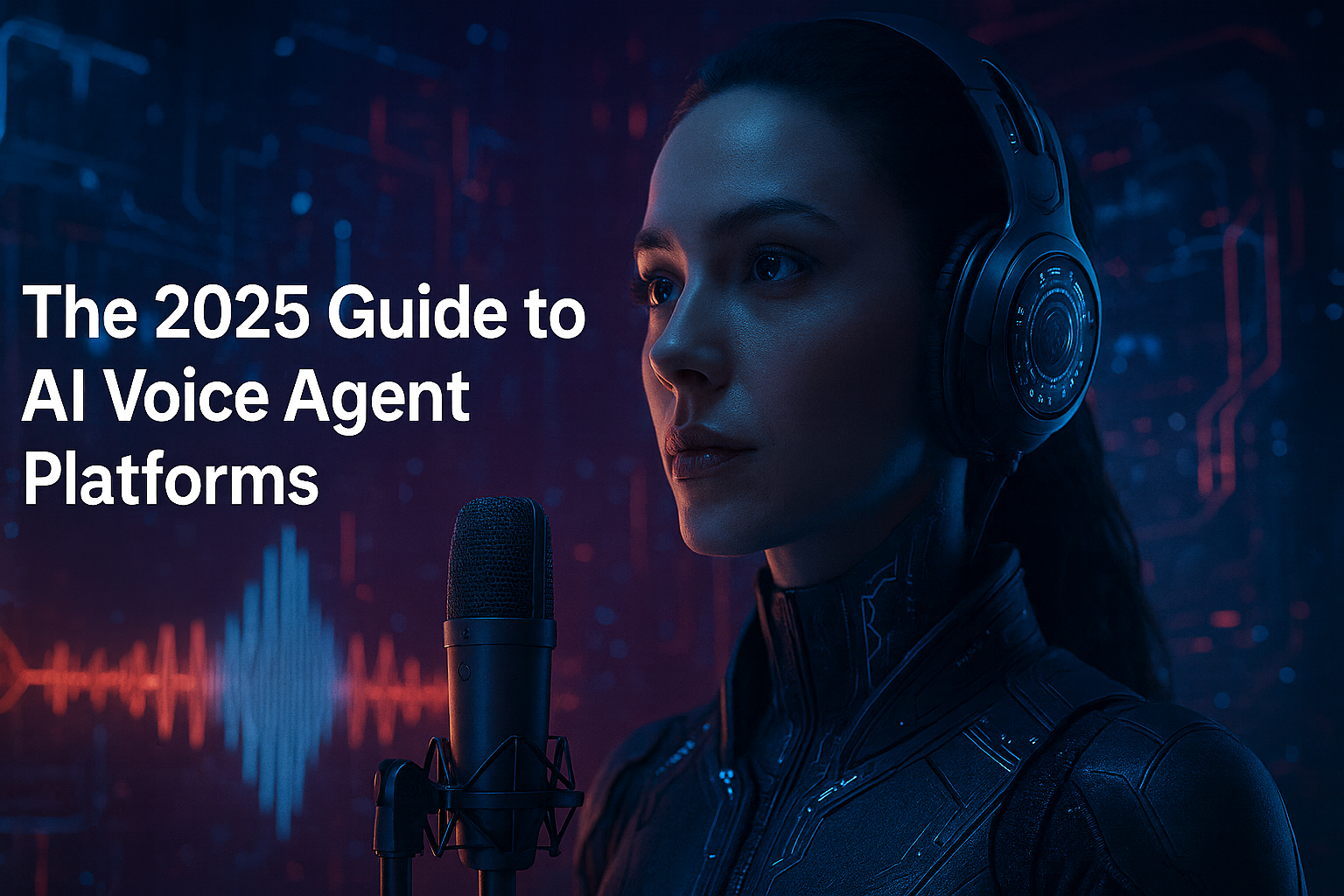The 2025 Guide to AI Voice Agent Platforms: Choosing the Right Fit for Sales, Support & Marketing
AI voice agents are no longer a demo—they’re ready to handle real customer calls. This guide explores the leading platforms, their strengths, pricing signals, and the caveats businesses must weigh before adoption.

AI voice agents have matured from clunky IVR replacements into low-latency, natural-sounding assistants that can handle outbound marketing calls, inbound support triage, and even complex self-service workflows. With dozens of vendors offering overlapping capabilities, the challenge isn’t finding a solution—it’s choosing the right one.
In this guide, we’ll compare the leading AI voice platforms, explore how they differ, and highlight the pros, cons, and caveats you should consider before handing over parts of your customer conversations to machines.
Why Businesses Are Paying Attention
The rise of AI voice agents in 2025 isn’t happening in a vacuum. A mix of customer expectations, technological leaps, and market momentum has pushed this space from “experimental” to “production-ready.”
1. Customer Experience Pressure
Contact centers face unprecedented strain. Customers expect instant responses, but businesses juggle long hold times, rising labor costs, and shrinking patience windows. Traditional IVRs (press 1 for billing, press 2 for support) are clunky and frustrating. AI voice agents promise to shorten queues, deflect repetitive queries, and free human agents for complex cases—improving both customer satisfaction (CSAT) and cost per call.
2. Technology Breakthrough
Until recently, speech AI lagged behind natural conversation. Latency was the killer—turnaround times of 2–3 seconds made bots feel robotic. Now, advances in real-time pipelines have changed the game:
- Streaming Speech-to-Text (STT): Engines like OpenAI Whisper Realtime, Deepgram, and Google ASR can transcribe speech nearly as fast as humans hear it.
- LLM Streaming: Instead of waiting for a full input, modern LLMs generate partial answers on the fly, enabling near-synchronous dialog.
- Neural Text-to-Speech (TTS): Platforms like ElevenLabs and Azure Neural Voices create natural speech in hundreds of milliseconds, not seconds.
- Barge-in support: Critical for natural dialog, this lets users interrupt the bot mid-sentence—something old IVR systems couldn’t handle.
The result? Conversations with AI voice agents now flow at human-like pace (500–900ms response time)—a subtle but decisive shift that makes the difference between frustration and adoption.
3. Market Heat
The ecosystem has exploded. Startups like Bland, Vapi, and Retell are raising rounds to productize developer-first voice stacks. At the same time, incumbents like Amazon (Connect + Lex), Google (Dialogflow CX), and Five9 are embedding AI voice deeply into contact center suites.
This dual momentum means businesses of all sizes can find an entry point: APIs for fast pilots, or enterprise CCaaS(Contact Center as a Service) suites for scale and compliance.
Recent coverage by The Wall Street Journal calls AI voice agents “ready to take your call” WSJ, while Financial Times highlights PolyAI’s funding as proof that investors see durable demand FT.
Categories of AI Voice Agent Platforms
1. Developer-First Voice Stacks
Designed for builders who need speed, flexibility, and APIs.
- OpenAI Realtime API – speech-to-speech with tool calling docs
- Deepgram Voice Agent API – one API for listen-think-speak intro
- ElevenLabs Conversational AI – realistic voices with telephony support overview
- LiveKit Agents + Telephony – realtime media fabric powering SIP/PSTN guide
- Vapi & Retell – packaged dev platforms with SIP, QA tools Vapi SIP | Retell SIP
- Bland AI – simple API with published rates, fast for outbound site
2. Enterprise CCaaS(Contact Center as a Service) Suites
Best for large operations needing compliance, routing, and workforce optimization.
- Amazon Connect + Lex pricing
- Google Dialogflow CX / CCAI phone gateway
- Azure Communication Services + Voice Live API overview
- Genesys Cloud CX integration
- Five9 IVA overview
- Talkdesk Autopilot voice AI
- NICE Enlighten XO datasheet
3. Vertical & Regional Specialists
Pre-built flows and domain expertise.
- PolyAI – production-grade assistants for call centers site
- Yellow.ai VoiceX – multilingual voice automation, strong APAC presence site
- Skit.ai – focus on collections and BFSI site
Pros, Cons & Caveats of Using AI Voice Agents
Pros
- Cost efficiency: Agents can reduce per-call handling costs, especially for repetitive FAQs and reminders.
- Scalability: Handle thousands of concurrent calls without adding headcount.
- 24/7 availability: No downtime, ideal for global businesses.
- Consistency: No mood swings, no human errors in script adherence.
- Data insights: Transcripts can be mined for customer behavior and journey mapping.
Cons
- Customer frustration: If latency is >1s or barge-in fails, users hang up.
- Edge case handling: Agents often stumble on unexpected phrasing or emotional conversations.
- Limited empathy: Voice tone helps, but true human empathy is still lacking.
- Vendor lock-in: CCaaS suites can trap you in bundled pricing; API-first stacks may tie you to model costs.
Caveats to Watch
- Compliance risk: Call recording laws (GDPR, TCPA, NDNC in India) still apply—you are liable.
- Hidden fees: Outbound call attempts, minimums, or number rentals (e.g., Bland’s $0.015/call for short outbound calls and $0.09/min for outbound) pricing.
- Integration gaps: : If your organization still uses a legacy PBX (private branch exchange) or on-premise phone system, make sure the AI voice agent platform supports SIP trunking or PSTN bridging. Without this capability, the agent won’t be able to connect seamlessly to your existing phone numbers or internal call routing, leaving you with dropped calls or the need for extra gateways.
- Handoff quality: Ensure seamless context transfer when escalating to humans.
- Data security: Evaluate redaction, PII handling, and SOC2/ISO compliance if in regulated industries.
Comparison Table (Quick Scan)
Tip: Use this as a shortlist builder. Always verify regional coverage, compliance, and SIP/PSTN support, then run a 2–3 week POC with your own call flows.
Platform | What it is | Telephony | Notable strengths | Pricing signals |
|---|---|---|---|---|
OpenAI Realtime API (docs) | Low-latency voice runtime with tool calling | WebRTC/WebSocket; PSTN via LiveKit/Vapi/Retell | Fast speech-to-speech, barge-in, tool use | Model/token usage; BYO telephony |
Deepgram Voice Agent API (intro) | Unified API (STT + LLM orchestration + TTS) | WebRTC/telephony providers | Single API, low latency, bring-your-own LLM/TTS | Usage-based (STT/TTS/Agent minutes) |
ElevenLabs Conversational AI (overview) | Voice agent layer built on ElevenLabs TTS | Native phone support + web/mobile | Ultra-realistic voices, barge-in, function calling | Usage-based; contact sales for telephony |
LiveKit Agents (telephony) | Real-time media framework for AI agents | Native SIP, DTMF, PSTN bridge | Proven infra; powers ChatGPT voice | Cloud usage + vendor model costs |
Vapi (SIP guide) | Developer platform for quick agent deployment | BYO SIP/PSTN, analytics | Fast time-to-market, QA tools, community | Per-minute + platform fees |
Retell AI (pricing) | Voice agent with flexible SIP integration | BYO SIP/Twilio/Telnyx | Strong telephony flexibility, configurable | Per-minute + LLM message tiers |
Bland AI (site) | API for outbound/inbound AI calls | Bundled telephony; Twilio option | Simple API, outbound campaigns | Public: $0.09/min outbound, inbound lower; numbers $15/mo |
Amazon Connect + Lex (pricing) | CCaaS with IVA via Amazon Lex | Full PSTN, global routing | Compliance, recording, WFM/WFO | Per-minute + bundled services |
Dialogflow CX / Google CCAI (phone gateway) | Dialog orchestration platform with phone support | Google-hosted gateway | Mature tooling, omnichannel | Usage + telecom rates |
Azure Communication Services + Voice Live (docs) | Telephony + real-time speech stack | PSTN/SIP + STT/TTS | Enterprise Azure governance, recording | Pay-as-you-go |
Genesys Cloud CX (integration) | Full CCaaS with AI bot integrations | Carrier-grade telephony | Routing, QA, analytics | Suite pricing; sales-led |
Five9 IVA (overview) | CCaaS with built-in IVA | Enterprise telephony | Full contact center feature set | Bundled; ~$149+/user/mo |
Talkdesk Autopilot (overview) | CCaaS voice bot (59 languages) | Voice + digital | Low-code builder, analytics | Usage add-ons; suite pricing |
NICE Enlighten XO (datasheet) | AI to optimize self-service flows | N/A (pairs with CCaaS) | Conversation mining, flow design | Enterprise licensing |
PolyAI (site) | Production-grade voice assistants | Telephony partners | Human-like, robust intent handling | Enterprise contracts |
Yellow.ai VoiceX (site) | Multilingual enterprise voice AI | Global telco partners | Rapid call deflection, APAC strength | Enterprise pricing |
Skit.ai (site) | Voice AI focused on BFSI/collections | Telephony integrations | Domain playbooks, compliance | Enterprise pricing |
Quick Guide: API vs. CCaaS vs. Specialist Platforms
Platform Type | Best For | Example Vendors | Typical Pricing |
|---|---|---|---|
Developer-first APIs | Startups, rapid pilots, outbound campaigns | OpenAI Realtime, Deepgram, Vapi, Retell, Bland | Per-minute + model usage |
Enterprise CCaaS | Contact centers, compliance-heavy ops | Amazon Connect, Genesys, Five9, Talkdesk | Bundled per-minute/seat pricing |
Specialists | Niche industries, regional focus | PolyAI, Yellow.ai, Skit.ai | Enterprise contracts |
Final Takeaway
AI voice agents are ready for production, but they’re not a wholesale human replacement. They shine when:
- You target narrow, high-volume intents (reminders, FAQs, status checks).
- You design seamless escalation to human agents.
- You account for regulatory, latency, and cost trade-offs.
The best approach? Run a 2–3 week pilot with your own call flows, measure deflection rate and customer sentiment, then decide whether to scale with a developer-first stack (flexibility) or a CCaaS suite (governance).


